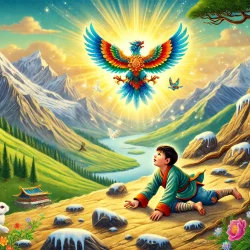SSLC English Question and Answer: The Bird of Happiness
Looking for SSLC English Studies textbook answers? You can download Chapter 4: The Bird of Happiness Questions and Answers PDF, Notes, and Summary here. SSLC English 2nd Language solutions follow the Karnataka State Board Syllabus, making it easier for students to revise and score higher in exams.
Karnataka SSLC 2nd Language English Textbook Answers—Reflections Supplementary Chapter 4
The Bird of Happiness Questions and Answers, Notes, and Summary
Class 10 2nd Language English Supplementary Chapter 4
The Bird of Happiness
Scroll Down to Download The Bird of Happiness PDF
Comprehension I: The Bird of Happiness
Question 1.
Will I ever make it?” Why did Wangjia feel so?
Answer:
Wangjia felt this way because he was undergoing immense physical and emotional suffering. He had already endured severe pain, hunger, and exhaustion, and the journey seemed endless. The sharp stones had torn his boots, feet, and hands, and he was crawling on the ground, bruised and battered. Despite his determination, the overwhelming challenges made him doubt whether he could complete his quest.
Question 2.
What hardships did Wangjia undergo on his way to find the Bird?
Answer:
Wangjia faced numerous hardships:
- He walked across a vast scree with sharp stones that tore his boots, feet, and hands.
- He endured starvation after the second monster blew away his food, leaving him in a barren desert.
- He became blind after the third monster gouged out his eyeballs.
- He crawled blindly for hundreds of miles, relying on his hands to feel his way forward.
- He suffered physical pain, hunger, and exhaustion throughout his journey.
Question 3.
What changes came over Wangjia as the Bird of Happiness caressed him?
Answer:
When the Bird of Happiness caressed Wangjia:
- His eyeballs returned to their sockets, and his vision became even clearer than before.
- All his wounds were healed.
- He felt stronger than ever.
- He was filled with joy and hope, knowing he had achieved his goal of finding the Bird of Happiness.
Question 4.
Contrast between the wishes of the monsters and Wangjia’s wish:
Answer:
- The monsters’ wishes were selfish and cruel. They demanded Wangjia to kill Lousang’s mother, poison old gaffer Silong, and gouge out Bhima’s eyeballs. These tasks required harming others for personal gain.
- Wangjia’s wish was selfless and noble. He sought the Bird of Happiness not for himself but to bring warmth, happiness, forests, flowers, fields, and rivers to his suffering people.
- The contrast highlights the difference between selfishness and selflessness. The folktale suggests that true happiness comes from compassion, sacrifice, and the desire to help others, rather than from harming others for personal gain.
Question 5.
Meaning of real happiness (Paragraph 1 and Paragraphs 28–29)
Answer:
- Paragraph 1 describes a life of suffering, where the people lacked basic necessities like warmth, food, and beauty. They longed for happiness but did not know what it was like.
- Paragraphs 28–29 show that real happiness is not just about material wealth but about harmony with nature, community well-being, and the presence of beauty and joy. The Bird of Happiness brought warmth, forests, flowers, rivers, and fields, transforming the barren land into a thriving, joyful place.
- Real happiness, as suggested by the story, is about creating a life filled with love, beauty, and abundance for everyone, not just for oneself.
Question 6.
What do you like the most in the story? Support your answer by giving reasons.
Answer:
- What I like most in the story is Wangjia’s unwavering determination and selflessness. Despite the immense suffering and seemingly impossible challenges, he never gave up or compromised his values. His refusal to harm others, even at the cost of his own pain, shows his moral strength and compassion.
- Additionally, the transformation brought by the Bird of Happiness is heartwarming. It shows how perseverance and selflessness can lead to profound positive change, not just for the individual but for the entire community. This message of hope and the power of good deeds is inspiring and timeless.
Question 7.
Read the story. Discuss with your partner and fill in the table given below.
Monster | Challenge Given | Wangjia’s Answer/Action |
First Monster | Ordered Wangjia to kill Lousang’s mother. | He loved his own mother and refused to harm another person’s mother. |
Second Monster | Demanded Wangjia to poison old gaffer Silong. | He was fond of his own grandpa and refused to kill another man’s grandfather. |
Third Monster | Ordered Wangjia to bring Bhima’s eyeballs. | He believed no one had the right to destroy a girl’s pretty eyes and refused to gouge Bhima’s eyes. |
Question 8.
We want to lead a happy life. What according to you can make us happy? Some ways are suggested below. Think whether they are practicable or impracticable. Discuss and Write them under the two columns appropriately.
- working hard to satisfy everybody’s wants.
- giving up all selfish desires.
- striking a balance between selfishness and sacrifice.
- working together for the good of all.
- leading a simple contented life
- devoting some time of the day for the good of others.
Answer:
| Practicable | Impracticable |
|---|---|
| ✅ Working together for the good of all. | ❌ Working hard to satisfy everybody’s wants. |
| Leading a simple, contented life. | Giving up all selfish desires. |
| Devoting some time of the day for the good of others. | Striking a balance between selfishness and sacrifice. |
Additional Questions and Answers: The bird of happiness
Question 1.
Why did the people of Tibet send Wangjia to find the Bird of Happiness?
Answer:
The people of Tibet sent Wangjia because they lived in a barren land with no rivers, green grass, or warmth. They suffered from hunger and cold and believed that the Bird of Happiness could bring them joy and prosperity. Wangjia, being brave and determined, was chosen to search for the bird.
Question 2.
How did Wangjia show determination during his journey?
Answer:
Despite facing severe hardships—walking on sharp scree, starving, and losing his eyesight—Wangjia never gave up. He continued crawling blindly toward the rising sun, believing that the Bird of Happiness would be in that direction. His determination and resilience helped him complete his mission.
Question 3.
How did the Bird of Happiness transform Wangjia’s homeland?
Answer:
When the Bird of Happiness cried out:
- The first cry brought sunlight and warmth, ending the cold.
- The second cry filled the mountains with forests, flowers, and birdsong.
- The third cry created green rivers, fields, and joyful animals.
Wangjia’s homeland became a place of beauty and abundance, and the people never suffered hardships again.
Question 4.
What moral values does Wangjia’s character represent?
Answer:
Wangjia represents courage, compassion, and selflessness. Despite the monsters’ threats and his own suffering, he remained kind and refused to harm others. His unwavering determination shows the power of goodness and the triumph of righteousness over evil.
The Bird of Happiness Summary

In ancient Tibet, people lived in a poor, barren land, suffering from hunger and cold. They believed that happiness existed far away in the form of a beautiful bird living on a snowy mountain, guarded by three fierce monsters. Despite the danger, a brave boy named Wangjia set out to find the Bird of Happiness.
On his journey, Wangjia faced three monstrous challenges. The first monster demanded that he kill Lousang’s mother, but Wangjia refused, valuing human life. In anger, the monster turned the road into sharp stones that tore Wangjia’s feet and hands. The second monster ordered him to poison old gaffer Silong. When Wangjia refused, the monster blew away his food, leaving him starving. The third monster demanded Bhima’s eyeballs, but Wangjia refused again. In fury, the monster blinded him.
Though weak and injured, Wangjia crawled toward the rising sun, where he finally met the Bird of Happiness. Touched by his bravery, the bird healed his wounds, restored his sight, and made him stronger. It carried Wangjia back to his village and, with three magical cries, transformed the barren land into a paradise with forests, rivers, and flowers. From that day on, the people never suffered again.
The tale highlights Wangjia’s courage, selflessness, and determination, showing that true happiness comes from kindness and resilience.
